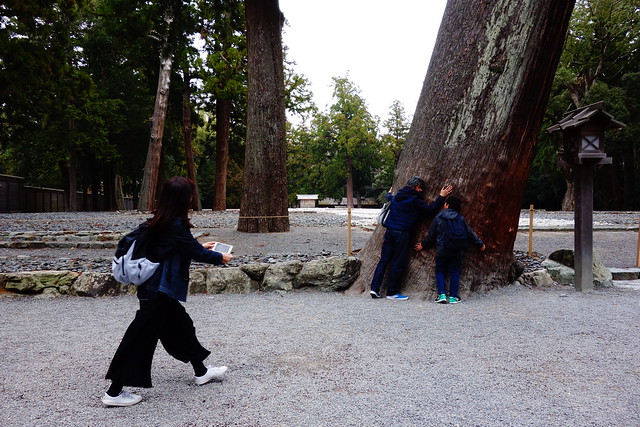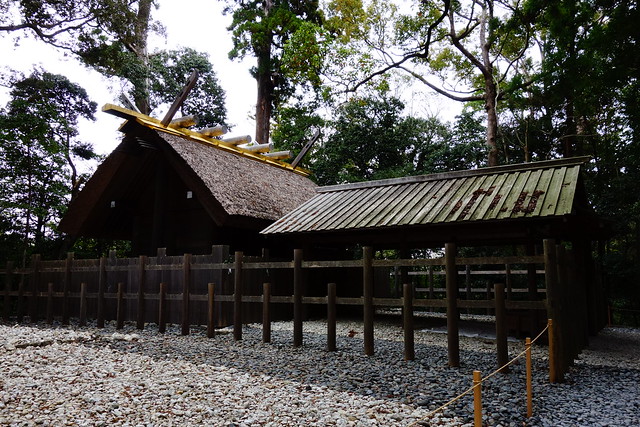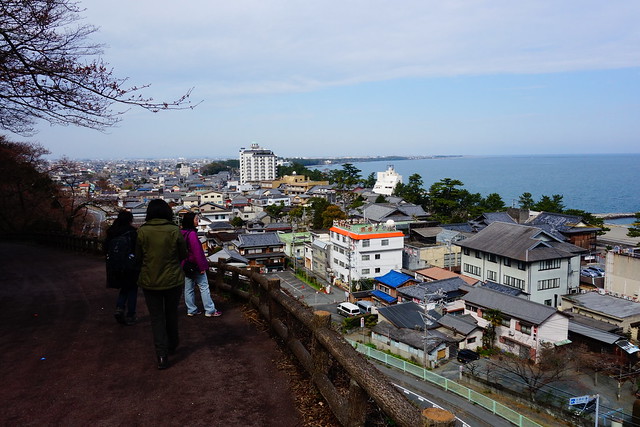The shrine complex is in two separate groups, referred to as inner and outer shrine, distanced by several kilometers of urban development. The shrine is required to be rebuilt every twenty years (each building has an empty footprint next to it), a convenient story to compensate for lack of real historical artifacts. The front door to every building is tightly shut, a gesture seemed rather off putting to me, but didn't seem to deter the enthusiasm of pilgrims. The town itself is rather charmless and sleepy. Where do all the "pilgrims" stay?!
The giant trees were the most impressive sight for me, as we have noticed at other shrines. I may suspect the Japanese of overfishing, burning trash, excessive packaging and disposables; but, hey have ancient trees all over the country, unseen anywhere else we have been.
Sun-Ling and the Jin Sisters in Ise.

Lots of folks posing for pics with this old tree, its truck worn bare from handling.

The Ise Outer Shrine. The first shrine was built on this spot about 1200 years ago. This building is less than 20 y.o. as the shrine is torn down and rebuilt on an adjacent site, now empty. More information about the Ise Shrine is here.

This is the adjacent empty site. The current shrine building is behind the fence to the left.

Here's one of the shrines that surround the Outer Shrine. It's a smaller version of the main shrine and is also rebuilt every 20 years on an adjacent site.



We each had a 5-day transport pass so we rode the bus to the Inner Shrine. One then has to walk about 15 minutes over a bridge (rebuilt every 20 years) and along the river to reach the Inner Shrine.


No photos are allowed of the Inner Shrine and you can't really get a good look at it either. Here's one of the smaller shrines. Looks a lot like the shrines at the Outer Shrine, no?

Ise was busy. A steady stream of tourists and pilgrims.

This is NOT the Inner shrine.


More sacred trees.

The shrine architecture is based on the design of rice storage buildings. Here's one.

Leaving the Inner Shrine we walked through the shopping/eating street on our way to the bus stop.

That night we managed to order some 99.9% vegetarian noodles at a local noodle joint.

Our train to Shinghu did leave until after 11 AM so we trained over to the coast to see the famous/sacred Meoto Iwa (Married Couple Rocks).


And there is a view (and Buddhist temple) on the hill above the rocks.



JR Futaminora Station.


2 comments:
Thanks. Now I don't feel bad about missing Ise!
@Kathy, Right. There was nothing out of the ordinary about this place other than the fact that 9 million people visit each year. It was not particularly spiritual, architectural interesting, or scenic, or hard to get to either. But I'm glad we came as the site gives meaning to the phrase "forever young", per Bob Dylan. Or as the Japanese say regarding Ise: Forever old, forever young.
Post a Comment